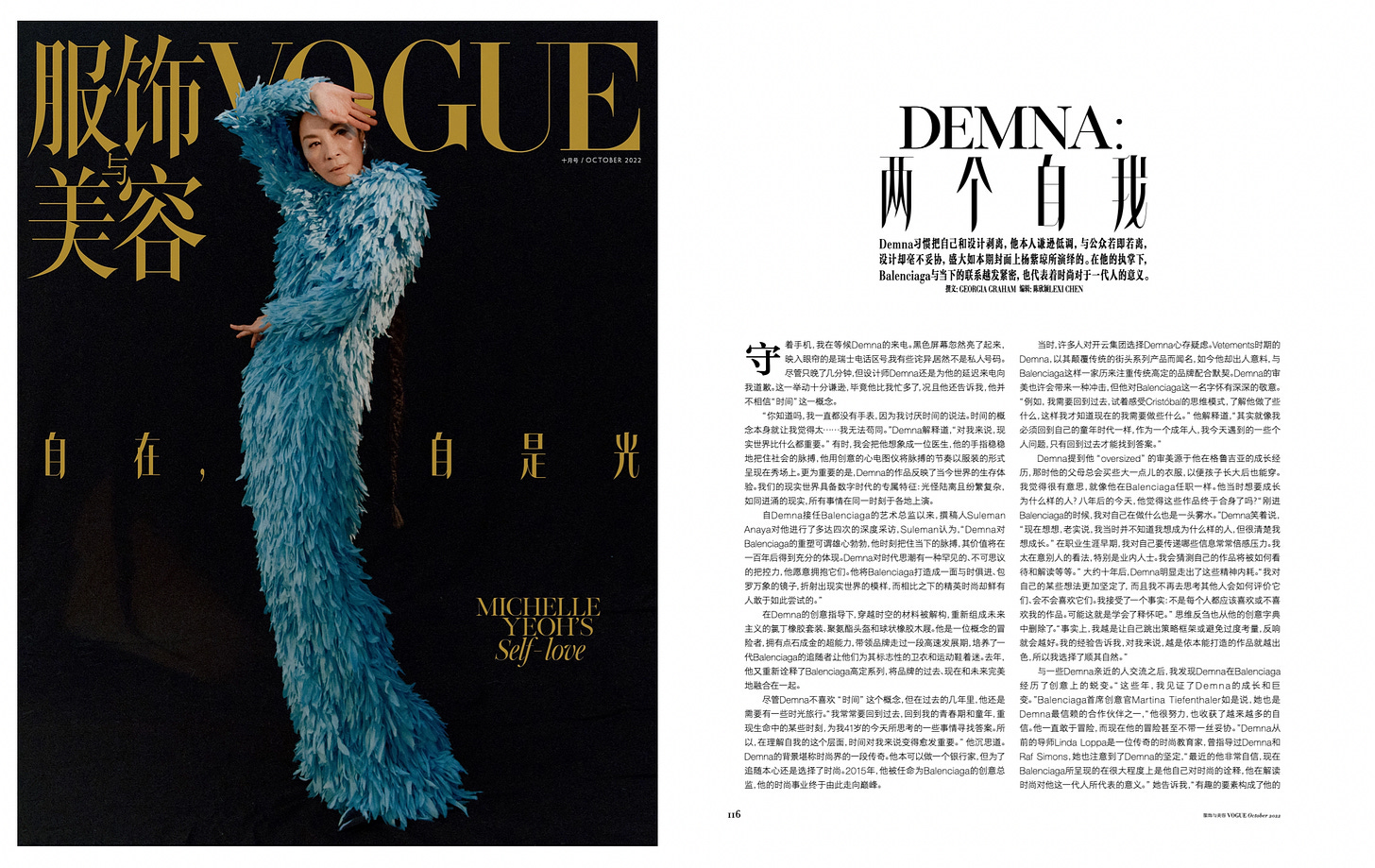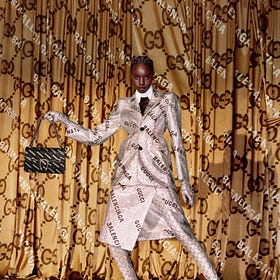A Thread about chatting to Demna
My interview with Balenciaga's outgoing creative director
Hi everyone! There’s no 3 Minute Thread today - instead, to commemorate his final collection for Balenciaga, I’m going to share a profile I wrote about Demna for Vogue China’s October 2022 issue. Unlike some celebrities I’ve interviewed, I found Demna to be very friendly and open. He didn’t feed me any pre-rehearsed PR lines, and the conversation was fun. I hope you find it interesting!

I’m sitting next to my phone, waiting for Demna to call. The black mirror lights up and I see a Swiss area code (I’m surprised it’s not a private number.) The designer apologises for being a few minutes late, a polite gesture from someone who is a. much busier and more and more important than me, and b. tells me that he doesn’t believe in time.
“You know, I never owned a watch in my life, because I’ve always kind of hated the idea. The concept of time itself, I find very... I just didn’t agree with it.” Demna explains. “Reality is so important for me.” Sometimes I think of him as doctor Demna, his finger placed firmly on the pulse of society; a creative ECG machine whose readings show up on the catwalk in the form of clothes. More than anything, Demna’s work reflects the experience of existing in the modern world - the eerie multilayering of reality that defines our digital age. Everything happening everywhere, all at once.
“I think Demna's reinvention of Balenciaga will be relevant 100 years from now thanks to its radical ambition and relentless nowness,” says Suleman Anaya, a writer who has interviewed the designer an impressive 4 times since his appointment at the house. “Demna has a rare, uncanny grasp of the Zeitgeist and willingness to embrace it. He turned the brand into an evolving, all-encompassing mirror of the moment, a place where elite fashion rarely dared to go.”
Under Demna’s creative direction, the fabric of time is unravelled, reconstituted into futuristic neoprene suits, polyurethane helmets and bulbous rubber clogs. He’s the conceptual risk taker with a Midas touch, overseeing a period of massive growth for the brand and fostering a generation of Balenciaga disciples dripping in his signature hoodies and sneakers. Last year, he revived the house’s couture offering, the ultimate synthesis of Balenciaga’s past, present and future.
Despite his aversion to the concept, a certain amount of time travel has been necessary for the designer over the past few years. “I had to go back a lot in time to repeat these moments in my life; in my adolescence, in my childhood, to find answers for certain things for which I need answers today, being 41. So, time has become more and more important to me in terms of understanding myself,” he muses.
Demna’s origin story has become the stuff of fashion legend - his family fled their home in Georgia to escape the civil war, settling in Germany as refugees. After training to become a banker, he quit to pursue his love of fashion, a journey which culminated in his appointment at Balenciaga in 2015.
Back then, many were sceptical about Kering’s choice. Known for his iconoclastic, streetwise collections at Vetements, the designer seemed a surprising match for a house steeped in couture history. But whilst his aesthetic might have been a shock, Demna clearly holds a deep reverence for the name above the door. “I need to go back in time to try to understand the mindset of Cristobal Balenciaga for example, and what he was doing with his house in order for me to know what I have to do today,” he explains. “It’s almost like the same way that I had to go back into my childhood to find answers to some issues, personal issues that I have today, being an adult.”
Demna has mentioned that his oversized aesthetic comes from his Georgian upbringing, where clothes were bought too big in order for children to grow into them. I’m interested in this as a metaphor for his Balenciaga tenure. What were the things that he was growing into? And now, after 8 years, does he feel like these pieces finally fit? “When I started at Balenciaga, I had no clue what I was starting!” Demna laughs. “Looking back now, I didn’t know what I wanted to grow into, but I knew that I wanted to grow.”
“Earlier in my career, I was more stressed about what message I would send out. I thought more about other people, especially within the industry. How my work would be seen, understood, etcetera.” After almost 10 years, it’s clear that Demna has outgrown this second-guessing.
“I feel much more sure and convinced about certain ideas that I have, and I don’t put them through this filter of how other people would judge them, or would they like them? I also accepted the fact that not everybody is supposed to like or not like [my work]. Maybe it’s part of learning how to let go.” Rumination has also been removed from his creative vocabulary. “The more I let myself do things without strategizing about it or overthinking, the more they work, actually. I’ve noticed that with experience. That the more it is instinctive, in my case, the better it is. So I just let it happen.”
Speaking with those close to him, it’s clear that Demna has undergone a creative metamorphosis during his time at Balenciaga. “I have seen Demna grow and transform enormously over the years,” says Martina Tiefenthaler, the brand’s Chief Creative Officer, and one of Demna’s most trusted collaborators. “He works hard on himself and has gained more and more confidence. He has always dared to run risks, but now he does that without compromises.”
This unwavering vision is also noted by Demna’s former tutor, Linda Loppa, the legendary fashion educator who schooled both Demna and Raf Simons. “Recently he is so confident that Balenciaga is very much his own interpretation of what fashion represents for a generation close to him,” she tells me. “The fun factor is becoming his playground, and the structure of the Balenciaga brand in the Kering company is giving him the space to use the playground in an amazing way.”
Still, whilst he might have grown in confidence as a designer, his steady ascent into the world of celebrity surely adds a different kind of pressure. In December 2021, he rebranded as Demna, dropping his last name altogether, and his use of masks suggests someone attempting to resist the glare of the public eye. I ask Demna how he feels about his growing fame. “I don’t really feel this celebrity of mine to be honest,” he responds. “Even if I have a contact for like, global celebrities in my phone, it doesn’t change anything. I’m still as I was when I was 7 or 8 years old, a kind of weirdo in my family.”
What about the ‘yes men’ I probe? I’m talking about the people who gather around those in power, telling exactly what they want to hear in order to remain in favour. “It’s actually kind of the opposite - I have more of the ‘no men’ than the ‘yes men’ in my team,” Demna says. “Because people know how I am, that I'd rather have a truthful no than not-such-a-truthful yes.”
He describes his process as very collaborative, seeking opinions from those around him. “I ask an intern in my design team for their opinion during the fitting, because I need to absorb those opinions in order to make mine,” he explains. “Very often I’ve changed my opinions because of what other people said to me, because I found some logic in it... that’s the only way to also be objective, and not to drown in some kind of deluded truth that you create yourself.”
His research process, however, is a solitary affair. At the time of our interview, Demna is about to embark on holiday, taking with him “about 10 boxes of books and magazines that I’ve acquired.” He’ll spend every day going through these, absorbing visual material which he then combines with screenshots from the past 6 months, creating moodboards which become the basis for future collections. “I feel really exhausted at the end of each day when I do that. It’s like watching 50 movies, that’s how it feels, because you absorb so much visual information.”
I ask him what he’s taking with him this time. “I just bought a whole collection of this old French magazine called Point de Vue from the 80s and 90s, because I’m doing a lot of research on the French bourgeoisie and how they dressed.” He tells me that he loves the work of Martin Parr, the British social photographer. “I have a very anthropological approach to my research, and for example Martin Parr’s photography is like that. He’s just capturing a moment of somebody’s life, and that’s why, when I go through these books, it can be very emotional... You almost see a movie of these people’s lives and imagine who they are, why are they dressed like this, what are they doing. It’s really straining your imagination in a very intense way.”
Indeed Martin Parr is a photographer whose work evokes the same feeling as Demna’s. Both men explore the banality of human existence, a paradoxical place where bright, saturated colours meet a darker, comic edge. Their work is sentimental and yet cynical; deeply felt yet dystopian. This brings us to the topic of humour, a Demna hallmark, and one which never fails to stir up controversy.
“I like to have a good laugh.” He tells me. “I have a sense of humour, I love to talk to people who also have a sense of humour. It’s just a part of human interaction, and it’s impossible for me to exclude it from my work.” (Later in our conversation I test this by pretending I don’t know who Kim Kardashian is. This makes Demna laugh.)
“Often it is some kind of comment on something - it’s just questioning things, but in a way that can be seen as funny but dark at the same time. It can be quite conceptual. Some funny things I did people found offensive, almost. You know, like taking something from a very mundane, daily context and putting it into the luxury brand vocabulary. People find it offensive. They’re like: ‘Oh, I can buy that for $5’. But you never thought to do that, until I put it there and made it very, very expensive.”
Here Demna could be talking about any number of items he’s created in recent years. Perhaps it’s the lookalike IKEA tote, retailing for around 2000 times the price of the original. Maybe it’s the latest evolution of this, the trompe l’oeil leather trash bag released a couple of weeks after our interview (it boasts a similar price tag to its predecessor, and was met with a similarly divisive reception.)
I ask him how he feels when people react this way. “Oh, I love it!” He responds. “Every time there is a reaction there is action.” I joke that his comments remind me of a poster I once saw that read: “Modern art = my kid could have done that. Yeah but they didn’t.” Demna laughs. “I did the DHL t-shirt years ago out of personal reasons to be honest. It was very dark humour on my part, and people were going crazy. “How come there is this t-shirt for 700 Euros?” But after that they started to produce them, and then you could buy them on Etsy for 5 dollars, but it didn’t happen before! Nobody wore a t-shirt that had a logo of a delivery service,” he recalls. “I love those triggers.”
Returning to the theme of time, I’m keen to ask Demna whether he ever considers his legacy? “You know, I go on the street and I see young kids wearing their clothes - which are not Balenciaga... but the way they put them together, the silhouettes and all of that, I see myself in there you know? In this kind of aesthetic,” he replies. “I started to notice that a year ago or something. On the street, on teenagers, and I thought: “This is my legacy.””
Somewhere inside Demna’s parallel universe, I hear the sound of an iPhone alarm and realise I’ve lost track of time. It feels fitting - with Demna, you’re never anywhere other than the here and now.
Have you listened to the Threads of Conversation podcast? You can also find it on Apple, Spotify, and YouTube. You can also follow Threads of Conversation on Instagram and TikTok. Subscribe below for more podcasts, essays and interviews.
Related Threads
A Thread about why Demna at Gucci makes sense
I’m not usually into astrology, but when a friend told me that last week was cosmic mayhem, I believed her. In fashion, two seismic pieces of news dropped within mere hours of one another. First, Donatella Versace announced her retirement, and then, news broke that Balenciaga designer Demna would be taking over at Gucci. There’s a lot to say on this top…
Threads of the week
Annual birthday bikini pic - Cancers love the beach! I’m wearing swimwear from Lido (the top is from the Tredici set and the bottoms are from the Venti.) I’ve worn these every summer for years and they still haven’t worn out! The body chain and necklace are by Santangelo and the sunglasses are vintage Chanel.
Loose Threads
Social media writer
’s latest trend report is as thorough and thought-provoking as ever. Although her work is focused on social media, it shows us how these channels are a lens on culture, not just platforms ‘over there’ where ‘content’ happens.Yay for Laura Weir, the new CEO of the British Fashion Council, who announced some super exciting changes to London Fashion Week. Can’t wait to see London back in the spotlight.
Anyone got $6 million dollars to buy the new Threads of Conversation HQ?
We’re chatting all things pigmentation over on TikTok.
Start your own Thread
What were your feelings about the final Balenciaga couture collection? Any Demna Gucci predictions? Leave your thoughts in the comments! And hit the heart button if you made it this far.




Thank you for the kind words!!